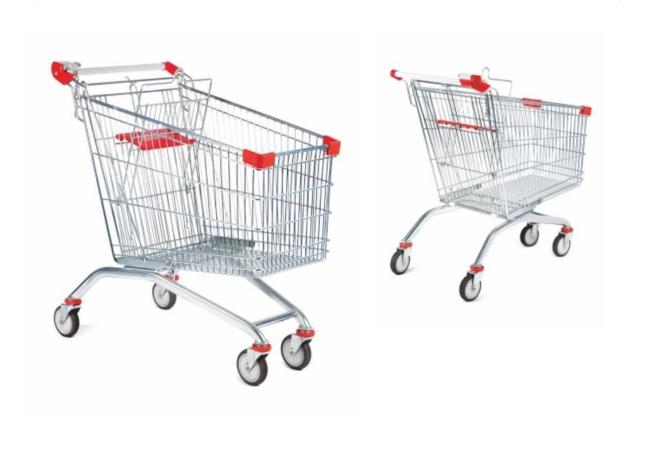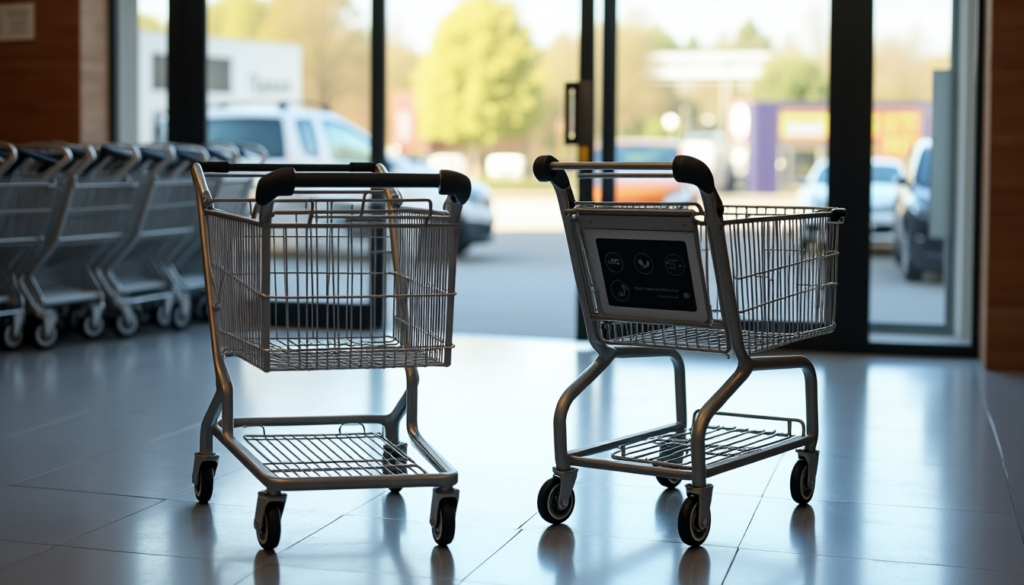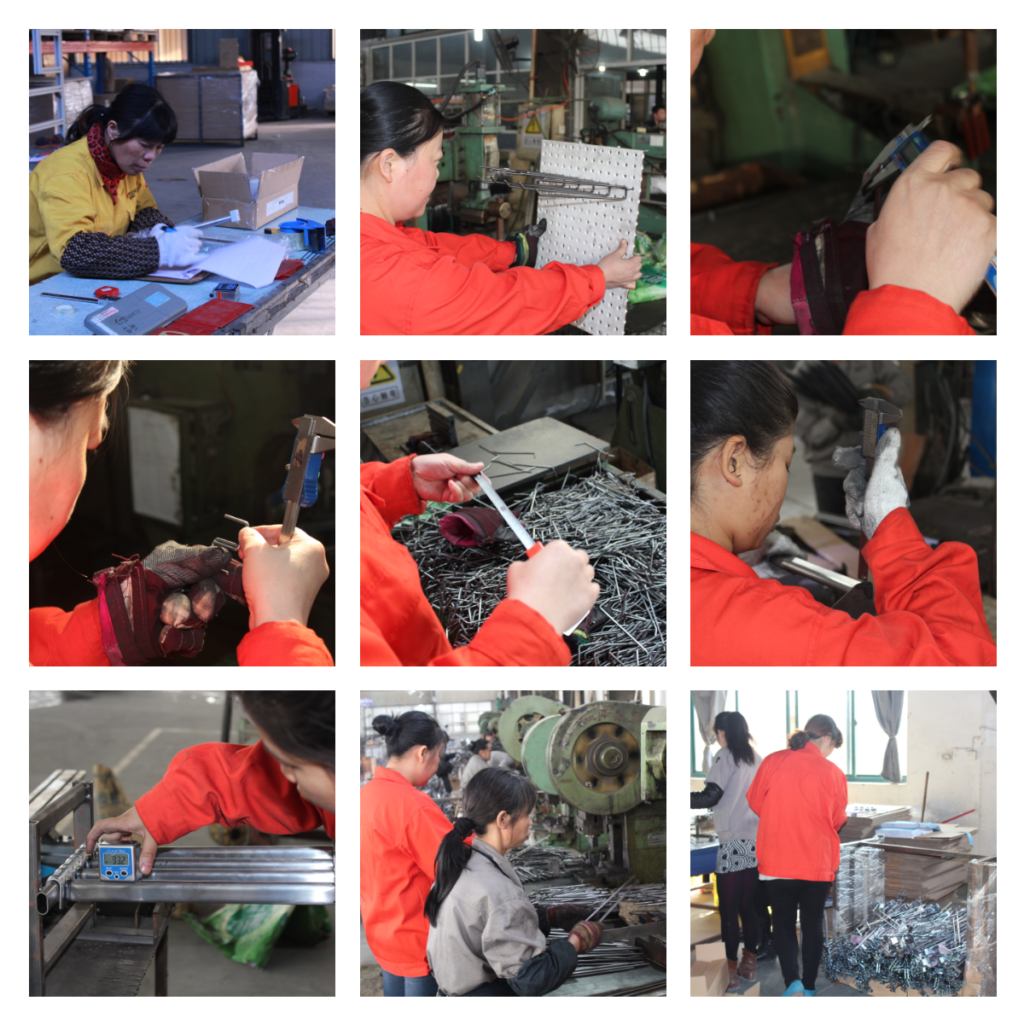12 years China Customzied Shop Fittings manufacturer

European Shopping Carts are designed for use in supermarkets and retail stores across Europe. They often feature four swivel wheels for easy maneuverability in smaller retail spaces and come in various sizes and styles to accommodate different shopping needs. Some models include accessories like child seats or dividers for organizing groceries. A notable feature is the coin-operated locking mechanism, which encourages shoppers to return carts after use
Shopping carts in Europe show a perfect mix of usefulness and local adaptation. The way Europeans design their carts tells us a lot about their cities and shopping habits.
Danish supermarkets led the way by adding metal carts with seats that fold near the handles. These early designs let carts fit together to save store space. Danish stores also came up with two different types of carts: regular carrying baskets and bigger ones with wheels that people could pull behind them.
European carts look quite different from what you’d see in America. The biggest difference? European carts have four wheels that turn all ways, while American ones keep their back wheels fixed. This makes it easier to move around in smaller European stores.
Today’s European carts come with some clever features. Dutch stores often use carts with fold-out trays that keep PET packages safe and make room for drink crates. The handles have gotten better too – many now have horn-shaped grips that give shoppers better control.
These carts are also built with health in mind. Many new European carts use special plastic parts that fight off germs between users. Plus, most handles now come with devices that stop static shocks – a nice touch for shoppers’ comfort.
European cities have shaped how these carts look and work. With their compact city centers and walking spaces, cart makers had to get creative. Venice offers the best example – their carts use two sets of three wheels to handle all those bridges.
You can really see how city layout affects cart design in bigger cities. Stores in busy areas often pick smaller carts or wheeled baskets instead of full-size ones. This makes sense given how tight space can be in European cities.
German supermarkets tell an interesting story about urban cart use. Most stores make everyone use a cart unless they’re shopping with someone else. This rule, plus recent changes from the pandemic, has pushed stores to think up new ways to arrange and space out their carts.
Swiss stores have taken things high-tech. Big chains like Migros and Coop now put hand scanners on their carts. Shoppers can check their total spending and pack their bags as they go. This works great for busy city shoppers who want to save time.
European shopping carts keep changing to match what people need and how cities work. From special wheel setups to germ-fighting materials, each new idea helps solve specific problems that come with European city life and shopping habits. These changes have given Europe its own unique answer to moving groceries around safely and quickly.

European shopping carts have evolved with remarkable technology that boosts the shopping experience.
Smart shopping carts now combine payment solutions right at the cart. These trailblazing systems come with built-in payment terminals for credit cards and digital wallets. Shoppers can finish their purchases without waiting in checkout lines. Cart payment systems have delivered impressive results, with basket sizes growing by 18% per visit.
Belgian supermarket chain Colruyt leads the way with a self-scanning system where customers scan products in their cart. The cart’s smart sensors and AI technology check the correct registration and weight of items. The system links to the Xtra app and shows up-to-the-minute shopping lists and total costs on the cart handle’s screen.
Modern European carts have grown more sophisticated in their navigation abilities. These smart carts work as personal digital assistants with interactive maps and precise indoor navigation. Smartcart and Navigine partnered to create a system that uses tablet sensors and BLE beacons throughout stores to track cart locations accurately.
Navigation systems bring several benefits:
The technology works well, with data showing that 30% of cart users buy items based on personalized promotional notifications.
Environmental awareness is the life-blood of modern European cart design. Cart makers now use recycled materials that cut energy use by 20% compared to traditional metal carts. Oceanis, a new line of recycled shopping carts, shows that each basket saves 1.5 meters of fishing rope from ocean disposal.
Green carts offer more benefits beyond materials:
Araven, a leading manufacturer, confirms that recycling 1kg of plastic saves 1.5kg of CO2 emissions. These sustainable carts feature unique aquamarine coloring that makes them stand out as eco-friendly options.
Smart features in these carts have revolutionized European retail. Stores using advanced carts report customer satisfaction scores of 9.1 out of 10, showing strong consumer acceptance of these technological breakthroughs. Retailers can now improve their store layouts and marketing strategies by analyzing customer movements and behavior.
The European shopping cart investment scene looks quite different from what we see in global markets. Retailers across the continent make their operational decisions based on price differences and how they plan to maintain their equipment.
Simple European shopping cart models cost around USD 30.00, while feature-rich premium versions can go up to USD 200.00. The manufacturing costs change based on several factors:
Steel shopping carts rule the European market today. They last longer and cost less to make thanks to laser cutting technology. Price differences between regions are a big deal as it means that Denmark’s consumer goods cost 45% more than the EU average, while Bulgaria’s prices stay 41% below.
You need to maintain carts well to make them last longer. Most European stores bring in professionals to check their carts every 12 to 18 months. The wheels need attention more than anything else because of:
Natural rubber wheels cost twice as much as polyurethane ones, but they’re worth it. They can last up to a decade when treated right. These premium wheels work well for 4-5 years even in busy stores.
The European shopping trolley business runs on simple manufacturing technology and budget-friendly maintenance costs. Retailers face a vital choice: they can spend more on quality parts now or replace cheaper ones more often. Many pick less expensive parts, which means they need more maintenance work later.
European maintenance protocols look like this:
Industry data shows that 12% of shopping carts get damaged and need repairs. This number shows why preventive maintenance matters so much in European retail. The European Green Deal also changes things up, as it affects what materials stores can use and how they maintain their carts.
Innovative laser cutting technology has made production faster while keeping quality high. The market keeps growing, and shopping cart needs should increase by 26.40% between 2021 and 2028.
Shopping habits across Europe tell us a lot about cultural diversity. The way people use their shopping carts shows how different cultures approach their grocery shopping.
European shopping habits have changed a lot. People used to visit supermarkets about 190 times a year five years ago. This number has dropped to 183 trips. French shoppers do things differently – they make fewer trips but buy more each time they visit.
COVID-19 changed everything about how people shop. Only 9% of people shopped online regularly before the pandemic. By May 2020, the numbers shot up – 44% of people started buying things online every week, and 23% headed to online stores multiple times weekly.
Culture plays a big role in how people shop. People from collectivist societies like to see everything at once on online platforms. This helps them process information better. That’s why Asian and South American countries buy more groceries online than Europeans.
Each European country has its own take on shopping cart sizes. French supermarkets like their carts big and deep, with special spots for bread, fruits, and vegetables. This makes sense because French people tend to shop less often but buy more.
British shoppers and others in Europe prefer smaller carts because they shop more often. Here’s why:
Where people live makes a big difference in how they shop across Europe. City folks walk more than those in rural areas. Rural shoppers buy fewer items but go for bigger products.
Online shopping has changed these old patterns. Rural Europeans save about two hours each month by shopping online. They save more time than city dwellers – 16% more in France and 8% more in Italy. Plus, 66% of rural folks can now buy things they couldn’t find in nearby stores.
City size affects what kind of shopping carts stores use. Crowded cities need smaller carts or wheeled baskets. Venice is a perfect example – they use special carts that can handle the city’s unique layout.
Different regions like different delivery options. Many European shoppers love Pick Up Drop Off points – especially in France (58%), Spain (50%), and the Netherlands (46%). This shows how Europeans think differently about picking up their shopping compared to Americans.
JY Shop Fitting’s Slatwall gondola shelving is the perfect choice for store owners with diverse needs. Whether for a garage, fashion store, or grocery store, our systems provide flexibility, durability, and style. Contact us to find the ideal shelving solution for your store, and for any inquiries, our team is here to assist.
Explore our range and transform your retail space today!
Q1. What are the main differences between European and American shopping carts? European carts typically feature four swiveling wheels for better maneuverability in compact spaces, while American carts have fixed back wheels. European carts are generally smaller and designed for narrower store aisles, reflecting different shopping patterns and store layouts.
Q2. Why do European stores use coin deposit systems for shopping carts? The coin deposit system (typically 50 cents to 1 euro) encourages shoppers to return carts to designated areas, reduces collection labor costs, and minimizes cart abandonment. This simple yet effective security measure has been widely adopted across Europe since the 1980s.
Q3. How have smart features enhanced modern European shopping carts? Modern European carts now include digital payment terminals, navigation systems with store maps, and real-time shopping list displays. These smart features have shown impressive results, with basket sizes increasing by 18% and customer satisfaction ratings reaching 9.1 out of 10.
Q4. How do shopping patterns differ between European regions? French shoppers tend to make fewer trips with larger purchases, preferring bigger carts with specialized compartments. In contrast, British and other European consumers shop more frequently and prefer smaller carts. Urban shoppers generally favor compact designs, while rural customers often opt for larger carts for bulk shopping.
Q5. What makes European shopping carts more environmentally friendly? Modern European carts are increasingly manufactured using recycled materials, reducing energy consumption by 20% compared to traditional metal carts. Each recycled cart prevents 1.5 meters of fishing rope from entering the ocean, and the manufacturing process decreases CO2 emissions by 20%.

JY has over a decade of providing one-stop metal shop fixture solution for all industry needs. With rich experience¸ we have a deep understanding about the unique challenges and requirements of our customers.